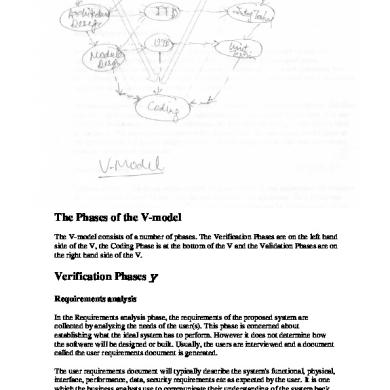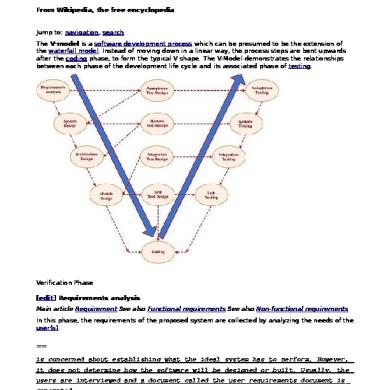V Model
This document was uploaded by user and they confirmed that they have the permission to share it. If you are author or own the copyright of this book, please report to us by using this DMCA report form. Report DMCA
Overview
Download & View V Model as PDF for free.
More details
- Words: 726
- Pages: 3
The Phases of the V-model The V-model consists of a number of phases. The Verification Phases are on the left hand side of the V, the Coding Phase is at the bottom of the V and the Validation Phases are on the right hand side of the V.
Verification Phases y Requirements analysis In the Requirements analysis phase, the requirements of the proposed system are collected by analyzing the needs of the user(s). This phase is concerned about establishing what the ideal system has to perform. However it does not determine how the software will be designed or built. Usually, the users are interviewed and a document called the user requirements document is generated. The user requirements document will typically describe the system's functional, physical, interface, performance, data, security requirements etc as expected by the user. It is one which the business analysts use to communicate their understanding of the system back to the users. The users carefully review this document as this document would serve as the guideline for the system designers in the system design phase. The user acceptance tests are designed in this phase.
System Design Systems design is the phase where system engineers analyze and understand the business of the proposed system by studying the user requirements document. They figure out possibilities and techniques by which the user requirements can be implemented. If any of the requirements are not feasible, the user is informed of the issue. A resolution is found and the user requirement document is edited accordingly. The software specification document which serves as a blueprint for the development phase is generated. This document contains the general system organization, menu structures, data structures etc. It may also hold example business scenarios, sample windows, reports for the better understanding. Other technical documentation like entity diagrams, data dictionary will also be produced in this phase. The documents for system testing is prepared in this phase.
Architecture Design The phase of the design of computer architecture and software architecture can also be referred to as high-level design. The baseline in selecting the architecture is that it should realize all which typically consists of the list of modules, brief functionality of each module, their interface relationships, dependencies, database tables, architecture diagrams, technology details etc. The integration testing design is carried out in this phase.
Module Design The module design phase can also be referred to as low-level design. The designed system is broken up into smaller units or modules and each of them is explained so that the programmer can start coding directly. The low level design document or program specifications will contain a detailed functional logic of the module, in pseudo code -database tables, with all elements, including their type and size. The unit test design is developed in this stage.
Validation Phases [•>
-\--------------
Unit Testing In the V-model of software development, unit testing implies the first stage of dynamic testing process. According to software development expert Barry Boehm, a fault discovered and corrected in the unit testing phase is more than a hundred times cheaper than if it is done after delivery to the customer. It involves analysis of the written code with the intention of eliminating errors. It also verifies that the codes are efficient and adheres to the adopted coding standards. Testing is usually white box. It is done using the Unit test design prepared during the module design phase. This may be carried out by software developers.^^i
Integration Testing
In integration testing the separate modules will be tested together to expose faults in the interfaces and in the interaction between integrated components. Testing is usually black box as the code is not directly checked for errors.
System Testing System testing will compare the system specifications against the actual system. The system test design is derived from the system design documents and is used in this phase. Sometimes system testing is automated using testing tools. Once all the modules are integrated several errors may arise. Testing done at this stage is called system testing.
User Acceptance Testing Acceptance testing is the phase of testing used to determine whether a system satisfies the requirements specified in the requirements analysis phase. The acceptance test design is derived from the requirements document. The acceptance test phase is the phase used by the customer to determine whether to accept the system or not.
Verification Phases y Requirements analysis In the Requirements analysis phase, the requirements of the proposed system are collected by analyzing the needs of the user(s). This phase is concerned about establishing what the ideal system has to perform. However it does not determine how the software will be designed or built. Usually, the users are interviewed and a document called the user requirements document is generated. The user requirements document will typically describe the system's functional, physical, interface, performance, data, security requirements etc as expected by the user. It is one which the business analysts use to communicate their understanding of the system back to the users. The users carefully review this document as this document would serve as the guideline for the system designers in the system design phase. The user acceptance tests are designed in this phase.
System Design Systems design is the phase where system engineers analyze and understand the business of the proposed system by studying the user requirements document. They figure out possibilities and techniques by which the user requirements can be implemented. If any of the requirements are not feasible, the user is informed of the issue. A resolution is found and the user requirement document is edited accordingly. The software specification document which serves as a blueprint for the development phase is generated. This document contains the general system organization, menu structures, data structures etc. It may also hold example business scenarios, sample windows, reports for the better understanding. Other technical documentation like entity diagrams, data dictionary will also be produced in this phase. The documents for system testing is prepared in this phase.
Architecture Design The phase of the design of computer architecture and software architecture can also be referred to as high-level design. The baseline in selecting the architecture is that it should realize all which typically consists of the list of modules, brief functionality of each module, their interface relationships, dependencies, database tables, architecture diagrams, technology details etc. The integration testing design is carried out in this phase.
Module Design The module design phase can also be referred to as low-level design. The designed system is broken up into smaller units or modules and each of them is explained so that the programmer can start coding directly. The low level design document or program specifications will contain a detailed functional logic of the module, in pseudo code -database tables, with all elements, including their type and size. The unit test design is developed in this stage.
Validation Phases [•>
-\--------------
Unit Testing In the V-model of software development, unit testing implies the first stage of dynamic testing process. According to software development expert Barry Boehm, a fault discovered and corrected in the unit testing phase is more than a hundred times cheaper than if it is done after delivery to the customer. It involves analysis of the written code with the intention of eliminating errors. It also verifies that the codes are efficient and adheres to the adopted coding standards. Testing is usually white box. It is done using the Unit test design prepared during the module design phase. This may be carried out by software developers.^^i
Integration Testing
In integration testing the separate modules will be tested together to expose faults in the interfaces and in the interaction between integrated components. Testing is usually black box as the code is not directly checked for errors.
System Testing System testing will compare the system specifications against the actual system. The system test design is derived from the system design documents and is used in this phase. Sometimes system testing is automated using testing tools. Once all the modules are integrated several errors may arise. Testing done at this stage is called system testing.
User Acceptance Testing Acceptance testing is the phase of testing used to determine whether a system satisfies the requirements specified in the requirements analysis phase. The acceptance test design is derived from the requirements document. The acceptance test phase is the phase used by the customer to determine whether to accept the system or not.
Related Documents

V Model
June 2020 6
V Model
November 2019 35
V Spec Concept Model
June 2020 11
Testing V Model
June 2020 5
Msf Team Model V.3
November 2019 10